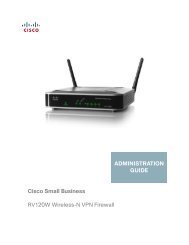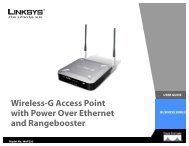Cisco Catalyst 6500 Supervisor 2T Architecture - Ipland
Cisco Catalyst 6500 Supervisor 2T Architecture - Ipland
Cisco Catalyst 6500 Supervisor 2T Architecture - Ipland
Create successful ePaper yourself
Turn your PDF publications into a flip-book with our unique Google optimized e-Paper software.
White Paperreserved for system use. This left two flow masks that could be used by the user. The main use for the two differentflow masks was with user-based rate limiting (UBRL), which allowed the user to configure different policers withdifferent flow masks. With the PFC4, there are now 80 flow masks available for use. Of the 80, there are 32 flowmasks for IPv4, 32 flow masks for IPv6, eight flow masks for MPLS, and eight flow masks for Layer 2 packet flows.Microflow policing can be performed on every NetFlow entry in the NetFlow data table. This means you couldpotentially have 512 K ingress microflow policers and 512 K egress microflow policers in action at the same timewhen the system operates in PFC4XL mode.While sampled NetFlow was available on the PFC3x forwarding engines, it was performed in software by the controlplane. Sampled NetFlow on the PFC4 is a new feature now supported by the Layer 3 forwarding engine as ahardware process. It offers a way to reduce the amount of information that is collected about a given flow. <strong>Supervisor</strong><strong>2T</strong> supports 1:N Sampling, a method which allows one packet to be chosen out of N packets (e.g. 1 per 1000).Sampling operates in a random mode, meaning any packet within sample N will be randomly selected. Samplers areglobal, and a total of 1 K NetFlow samplers are supported.A third piece of memory (ICAM) is also used for NetFlow. This piece of memory is used to store flows that have aconflict, due to a hash collision or page full condition in the primary NetFlow table. The ICAM can support 16 NetFlowentries that are shared between the IFE and OFE processes. Given the 99 percent efficiency of the NetFlow hashingalgorithm and the aging mechanisms to age out flows that have ended, the likelihood of needing this ICAM is greatlydecreased.Layer 3 Processing and the Forwarding Information Base/Adjacency TablesThe Forwarding Information Base (FIB) table contains a hardware representation of the Layer 3 forwarding tablesfound in the control plane. The <strong>Catalyst</strong> <strong>6500</strong> uses <strong>Cisco</strong> Express Forwarding (CEF) architecture to enable hardwareforwarding. The routing protocols collect next-hop information about the routing topology, and maintain this in theirrespective protocol tables in the control plane. This forwarding information is consolidated into the global routingtable called the RIB (Routing Information Base). CEF then takes this global routing table (RIB) and creates a FIBtable that is pushed down into the PFC4/DFC4 FIB TCAM. All Layer 3 forwarding in hardware uses this FIB table toperform Layer 3 forwarding lookups.The FIB in the PFC4 contains 256 K entries, while the FIB in the PFC4XL contains 1 million entries. These are thesame as their PFC3x forwarding engine counterparts. The FIB in the PFC4 contains prefix entries for IPv4 and IPv6global address, IPv4 and IPv6 multicast addresses and MPLS label entries. There is a level of partitioning that existsto ensure there is always some space available for different types of forwarding entries. There is some flexibility froma user configuration standpoint that allows these partition boundaries to be changed to accommodate more of onetype of forwarding entry. For example, in the PFC4XL, the default setting provides for 512 K IPv4 entries, and thiscan be increased through configuration control to support up to 1 M entries if required.The PFC4 FIB is actually comprised of two memory blocks: one is TCAM-based and the other is RLDRAM-based.When performing a Layer 3 lookup, the FIB TCAM lookup is performed first. To execute the lookup, a FIB TCAMlookup key is derived, based on incoming packet type and other fields, to perform a FIB TCAM lookup. The result ofthe FIB lookup returns a pointer into the FIB RLDRAM, which will hold a pointer into the adjacency table for normalforwarded packets. If the adjacency pointer indicates the destination can be reached through multiple paths, itcomputes a unique adjacency pointer for each path.With the earlier PFC3x on the Sup 720, the adjacency table also contained rewrite information for rewriting the Layer2 header, when the packet left the switch. With the PFC4, this information has now been moved to the rewrite table(discussed later). The adjacency table contains a pointer to the LTL (Local Target Logic) index. The LTL index is aninternal pointer that represents an interface in the switch, which essentially identifies the egress interface out of© 2011-2012 <strong>Cisco</strong> and/or its affiliates. All rights reserved. This document is <strong>Cisco</strong> Partner Confidential Information. Page 38 of 46
















